Bandwidth-Aware Traffic Sensing in Vehicular Networks with Mobile Edge Computing
Abstract
1. Introduction
- First, we propose an MEC-based service architecture for traffic sensing system in vehicular networks, where each MEC server is responsible for managing the data upload of vehicles in its service range and estimating the traffic state based on collected data set.
- Second, we formulate the problem of bandwidth-constrained traffic sensing (BCTS) by synthesizing the heterogeneous capacities of MEC servers and dynamic mobility features of vehicles, which aims at minimizing the estimation error between the original traffic state and the estimated traffic state.
- Third, to tackle the BCTS problem, we propose two algorithms for data collection and data recovery, respectively. First we propose a bandwidth-aware data collection (BDC) for selecting the optimal upload data set by adaptively capturing the temporal and spatial correlation of traffic data base on historical data set. Furthermore, we propose a convex-based data recovery (CDR) algorithm to estimate the full traffic state in the whole sensing area by transforming the BCTS problem into a norm minimization problem.
- Fourth, we implement the system model by integrating the realistic traffic data with real-world map, as well as the proposed algorithm. The comprehensive simulation result shows the superiority of the proposed algorithms compared with two competitive algorithms under various circumstances.
2. Related Work
3. System Model
4. Problem Formulation
4.1. Preliminary
4.2. Bandwidth-Constrained Traffic Sensing
5. Algorithm Design
5.1. Compressive Sensing-Based Singular Value Decomposition
5.2. Bandwidth-Aware Data Collection Algorithm
| Algorithm 1 The Bandwidth-aware Data Collection (BDC) Algorithm |
| Input: Historical data set , Output: The collected traffic state matrix and indicator matrix , Step 1: determine the selection priority of the road segments (Offline Phase)
|
5.3. Convex-Based Data Recovery Algorithm
| Algorithm 2 The Convex-based Data Recovery (CDR) Algorithm |
| Input: Collected traffic state matrix , indication matrix , regularization coefficient , rank factor r, and learning rating Output: Estimation matrix
|
6. Performance Evaluation
6.1. Setup
6.2. Simulation Results
6.2.1. Effect of Parameters
6.2.2. Effect of Communication Capacity
6.2.3. Effect of Covered Road Segment Number
6.2.4. Effect of MEC-Based and Centralized Architectures
6.2.5. Effect of Additive Noise
7. Conclusions and Future Work
Author Contributions
Funding
Conflicts of Interest
References
- Barka, E.; Kerrache, C.A.; Lagraa, N.; Lakas, A. Behavior-aware UAV-assisted crowd sensing technique for urban vehicular environments. In Proceedings of the 2018 15th IEEE Annual Consumer Communications Networking Conference (CCNC), Las Vegas, NV, USA, 12–15 January 2018; pp. 1–7. [Google Scholar] [CrossRef]
- Du, R.; Chen, C.; Yang, B.; Lu, N.; Guan, X.; Shen, X. Effective Urban Traffic Monitoring by Vehicular Sensor Networks. IEEE Trans. Veh. Technol. 2015, 64, 273–286. [Google Scholar] [CrossRef]
- Dai, P.; Liu, K.; Zhuge, Q.; Sha, E.H.; Lee, V.C.S.; Son, S.H. Quality-of-Experience-Oriented Autonomous Intersection Control in Vehicular Networks. IEEE Trans. Intell. Transp. Syst. 2016, 17, 1956–1967. [Google Scholar] [CrossRef]
- De Souza, A.M.; Boukerche, A.; Maia, G.; Cerqueira, E.; Loureiro, A.A.F.; Villas, L.A. SPARTAN: A Solution to Prevent Traffic Jam with Real-Time Alert and Re-Routing for Smart City. In Proceedings of the 2016 IEEE 84th Vehicular Technology Conference (VTC-Fall), Montreal, QC, Canada, 18–21 September 2016; pp. 1–5. [Google Scholar] [CrossRef]
- Shen, Y.; Lee, J.; Jeong, H.; Jeong, J.; Lee, E.; Du, D.H.C. SAINT+: Self-Adaptive Interactive Navigation Tool+ for Emergency Service Delivery Optimization. IEEE Trans. Intell. Transp. Syst. 2018, 19, 1038–1053. [Google Scholar] [CrossRef]
- Zhang, Z.H.D. Cost-efficient traffic-aware data collection protocol in VANET. Ad Hoc Netw. 2017, 55, 28–39. [Google Scholar] [CrossRef]
- Wu, D.; Arkhipov, D.I.; Kim, M.; Talcott, C.L.; Regan, A.C.; McCann, J.A.; Venkatasubramanian, N. ADDSEN: Adaptive Data Processing and Dissemination for Drone Swarms in Urban Sensing. IEEE Trans. Comput. 2017, 66, 183–198. [Google Scholar] [CrossRef]
- Guo, J.; Song, B.; He, Y.; Yu, F.R.; Sookhak, M. A Survey on Compressed Sensing in Vehicular Infotainment Systems. IEEE Commun. Surv. Tutor. 2017, 19, 2662–2680. [Google Scholar] [CrossRef]
- Lin, L.; Pccta, S.; Wang, J. Efficient Collection of Connected Vehicle Data based on Compressive Sensing*. In Proceedings of the 2018 21st International Conference on Intelligent Transportation Systems (ITSC), Maui, HI, USA, 4–7 November 2018; pp. 3427–3432. [Google Scholar] [CrossRef]
- He, Z.; Zheng, L.; Chen, P.; Guan, W. Mapping to Cells: A Simple Method to Extract Traffic Dynamics from Probe Vehicle Data. Comput. Aided Civ. Infrastruct. Eng. 2017, 32, 252–267. [Google Scholar] [CrossRef]
- Xie, K.; Luo, W.; Wang, X.; Xie, D.; Cao, J.; Wen, J.; Xie, G. Decentralized Context Sharing in Vehicular Delay Tolerant Networks with Compressive Sensing. In Proceedings of the 2016 IEEE 36th International Conference on Distributed Computing Systems (ICDCS), Nara, Japan, 27–30 June 2016; pp. 169–178. [Google Scholar] [CrossRef]
- Padalkar, S.; Korlekar, A.; Pacharaney, U. Data gathering in wireless sensor network for energy efficiency with and without compressive sensing at sensor node. In Proceedings of the 2016 International Conference on Communication and Signal Processing (ICCSP), Melmaruvathur, India, 6–8 April 2016; pp. 1356–1359. [Google Scholar] [CrossRef]
- Masini, B.M.; Bazzi, A.; Zanella, A. A Survey on the Roadmap to Mandate on Board Connectivity and Enable V2V-Based Vehicular Sensor Networks. Sensors 2018, 18, 2207. [Google Scholar] [CrossRef] [PubMed]
- Li, W.; Nie, D.; Wilkie, D.; Lin, M.C. Citywide Estimation of Traffic Dynamics via Sparse GPS Traces. IEEE Intell. Transp. Syst. Mag. 2017, 9, 100–113. [Google Scholar] [CrossRef]
- Ramazani, A. CANS: Context-aware traffic estimation and navigation system. IET Intell. Transp. Syst. 2017, 11, 326–333. [Google Scholar] [CrossRef]
- Liu, J.; Wan, J.; Zeng, B.; Wang, Q.; Song, H.; Qiu, M. A Scalable and Quick-Response Software Defined Vehicular Network Assisted by Mobile Edge Computing. IEEE Commun. Mag. 2017, 55, 94–100. [Google Scholar] [CrossRef]
- Zhang, K.; Mao, Y.; Leng, S.; He, Y.; ZHANG, Y. Mobile-Edge Computing for Vehicular Networks: A Promising Network Paradigm with Predictive Off-Loading. IEEE Veh. Technol. Mag. 2017, 12, 36–44. [Google Scholar] [CrossRef]
- Alasmary, W.; Valaee, S. Compressive sensing based vehicle information recovery in vehicular networks. In Proceedings of the 2013 9th International Wireless Communications and Mobile Computing Conference (IWCMC), Sardinia, Italy, 1–5 July 2013; pp. 700–705. [Google Scholar] [CrossRef]
- Wang, H.; Zhu, Y.; Zhang, Q. Compressive sensing based monitoring with vehicular networks. In Proceedings of the 2013 Proceedings IEEE INFOCOM, Turin, Italy, 14–19 April 2013; pp. 2823–2831. [Google Scholar] [CrossRef]
- Liu, C.; Chigan, C.; Gao, C. Compressive sensing based data collection in VANETs. In Proceedings of the 2013 IEEE Wireless Communications and Networking Conference (WCNC), Shanghai, China, 7–10 April 2013; pp. 1756–1761. [Google Scholar] [CrossRef]
- Jiang, R.; Zhu, Y.; Wang, H.; Gao, M.; Ni, L.M. Compressive data retrieval with tunable accuracy in vehicular sensor networks. In Proceedings of the International Conference on Wireless Algorithms, Systems, and Applications, Zhangjiajie, China, 7–10 August 2013; Volume 7992, pp. 426–439. [Google Scholar]
- Hu, M.; Zhong, Z.; Chen, W. Sparse Erroneous Vehicular Trajectory Compression and Recovery via Compressive Sensing. In Proceedings of the 2014 IEEE 11th International Conference on Mobile Ad Hoc and Sensor Systems, Philadelphia, PA, USA, 28–30 October 2014; pp. 668–673. [Google Scholar] [CrossRef]
- Lee, J. Design of a Network Coverage Analyzer for Roadside-to-Vehicle Telematics Networks. In Proceedings of the 2008 Ninth ACIS International Conference on Software Engineering, Artificial Intelligence, Networking, and Parallel/Distributed Computing, Phuket, Thailand, 6–8 August 2008; pp. 201–205. [Google Scholar] [CrossRef]
- Xu, D.W.; Dong, H.H.; Li, H.J.; Jia, L.M.; Feng, Y. The estimation of road traffic states based on compressive sensing. Transp. B Transp. Dyn. 2015, 3. [Google Scholar] [CrossRef]
- Chen, Y.C.; Qiu, L.; Zhang, Y.; Xue, G.; Hu, Z. Robust network compressive sensing. In Proceedings of the 2011 31st International Conference on Distributed Computing Systems, Maui, HI, USA, 7–11 September 2014; pp. 545–556. [Google Scholar]
- Li, Z.; Zhu, Y.; Zhu, H.; Li, M. Compressive Sensing Approach to Urban Traffic Sensing. In Proceedings of the 2011 31st International Conference on Distributed Computing Systems, Minneapolis, MN, USA, 20–24 June 2011; pp. 889–898. [Google Scholar] [CrossRef]
- Huang, X.; Yu, R.; Kang, J.; He, Y.; Zhang, Y. Exploring Mobile Edge Computing for 5G-Enabled Software Defined Vehicular Networks. IEEE Wirel. Commun. 2017, 24, 55–63. [Google Scholar] [CrossRef]
- Li, L.; Li, Y.; Hou, R. A Novel Mobile Edge Computing-Based Architecture for Future Cellular Vehicular Networks. In Proceedings of the 2017 IEEE Wireless Communications and Networking Conference (WCNC), San Francisco, CA, USA, 19–22 March 2017; pp. 1–6. [Google Scholar] [CrossRef]
- Xia, X.; Zhou, Y.; Li, J.; Yu, R. Quality-Aware Sparse Data Collection in MEC-Enhanced Mobile Crowdsensing Systems. IEEE Trans. Comput. Soc. Syst. 2019, 1–12. [Google Scholar] [CrossRef]
- De Lathauwer, L.; De Moor, B.; Vandewalle, J. A Multilinear Singular Value Decomposition. SIAM J. Matrix Anal. Appl. 2000, 21, 1253–1278. [Google Scholar] [CrossRef]
- Recht, B.; Fazel, M.; Parrilo, P. Guaranteed Minimum-Rank Solutions of Linear Matrix Equations via Nuclear Norm Minimization. SIAM Rev. 2010, 52, 471–501. [Google Scholar] [CrossRef]
- Data Source: Didi Chuxing GAIA Initiative. Available online: https://gaia.didichuxing.com (accessed on 6 January 2019).
- Chen, C.; Ding, Y.; Xie, X.; Zhang, S. A three-stage online map-matching algorithm by fully using vehicle heading direction. J. Ambient Intell. Humaniz. Comput. 2018, 9, 1623–1633. [Google Scholar] [CrossRef]
- Gao, W.; Oh, S.; Viswanath, P. Demystifying Fixed k-Nearest Neighbor Information Estimators. IEEE Trans. Inf. Theory 2018, 64, 5629–5661. [Google Scholar] [CrossRef]
- Ghosh, S.; Asif, M.T.; Wynter, L. Denoising autoencoders for fast real-time traffic estimation on urban road networks. In Proceedings of the 2017 IEEE 56th Annual Conference on Decision and Control (CDC), Melbourne, Australia, 12–15 December 2017; pp. 6307–6312. [Google Scholar] [CrossRef]
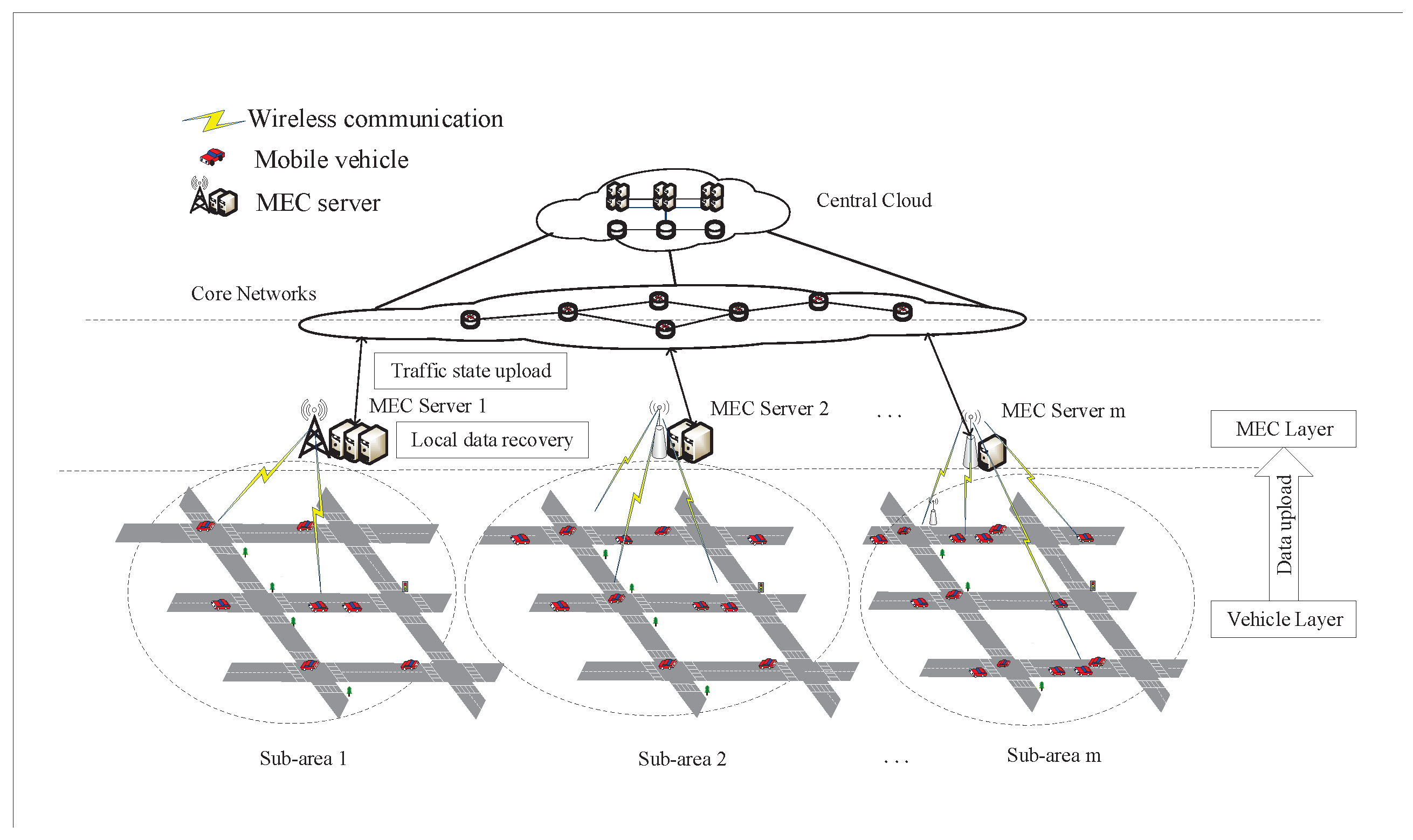
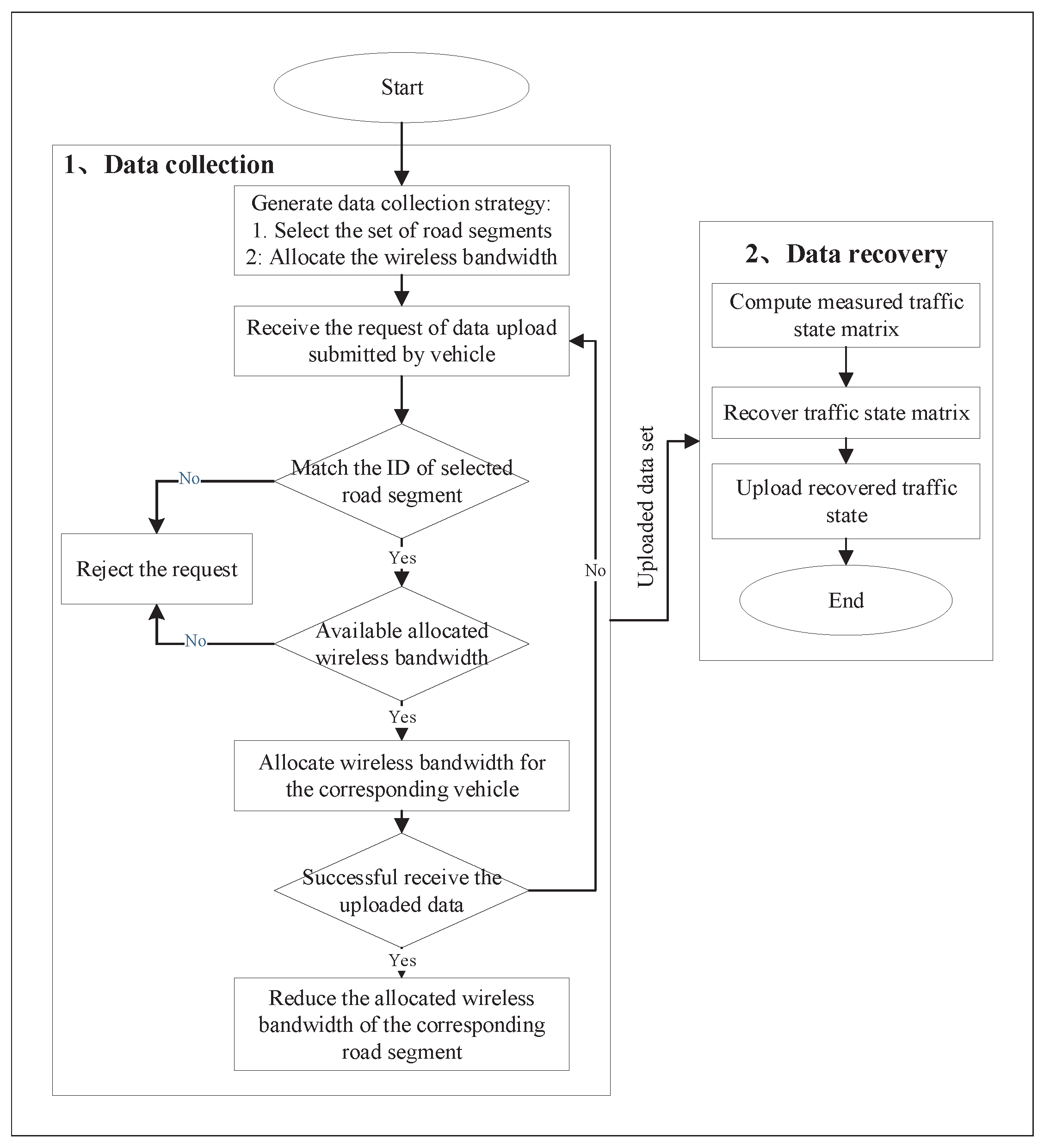
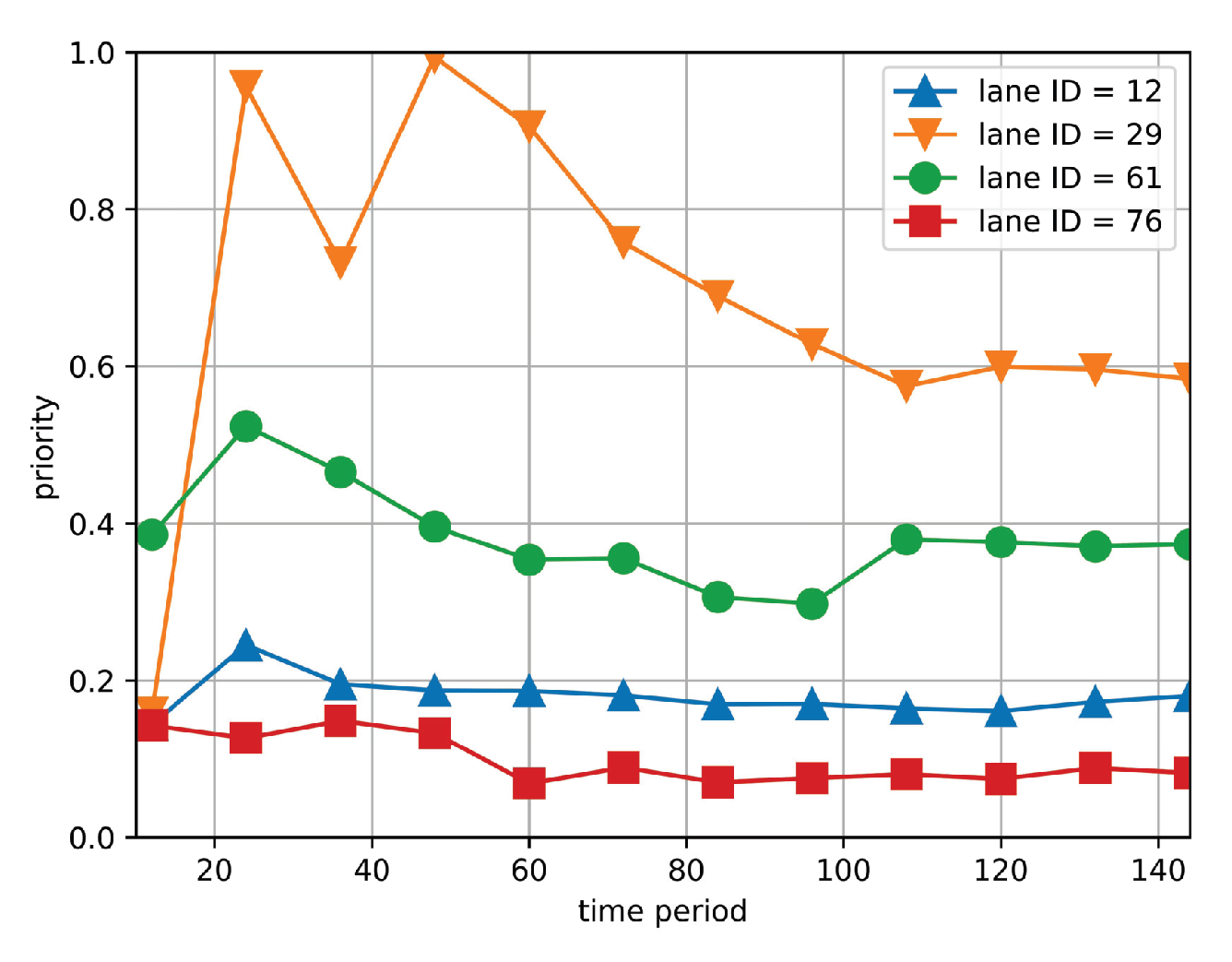
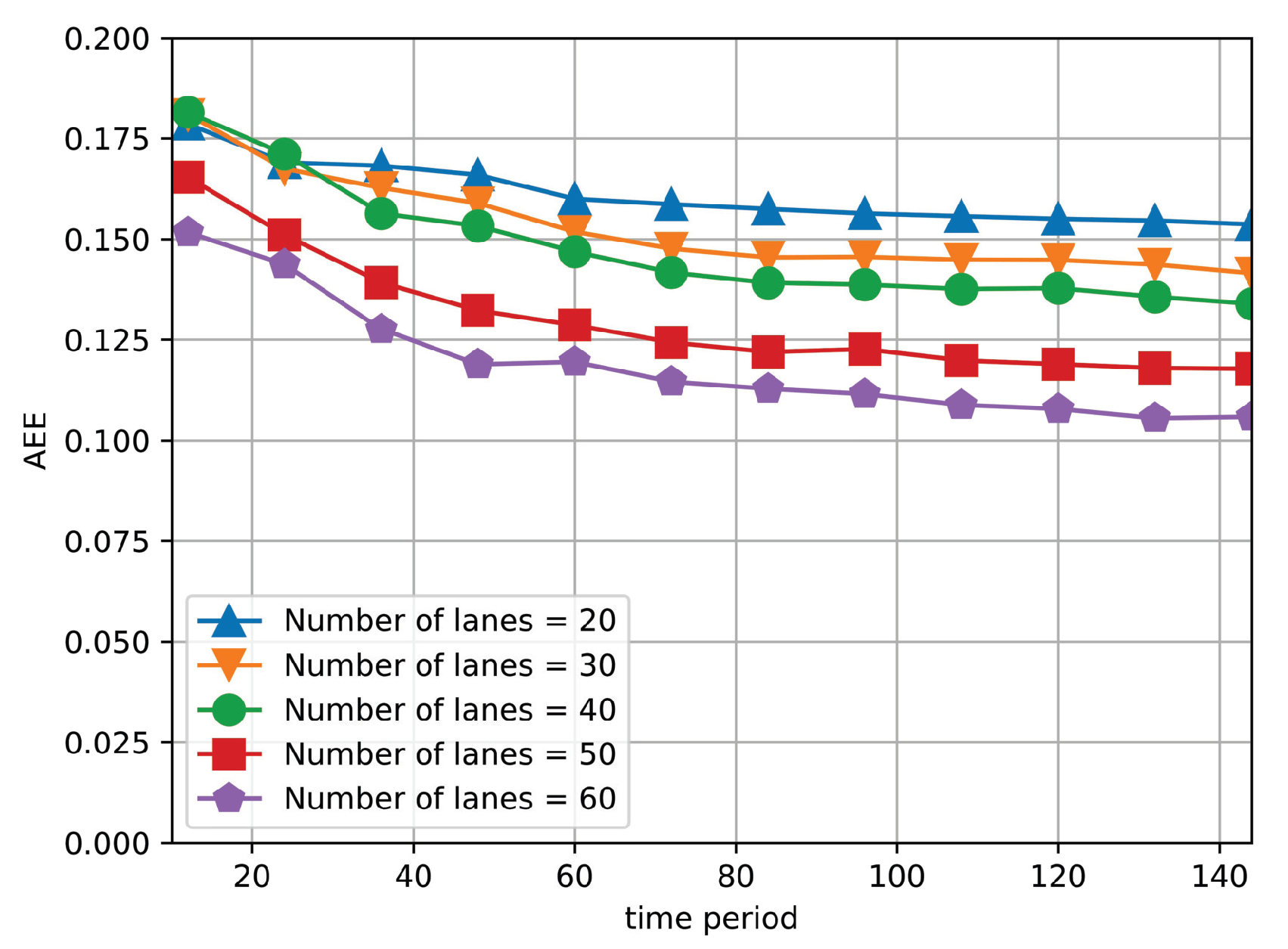

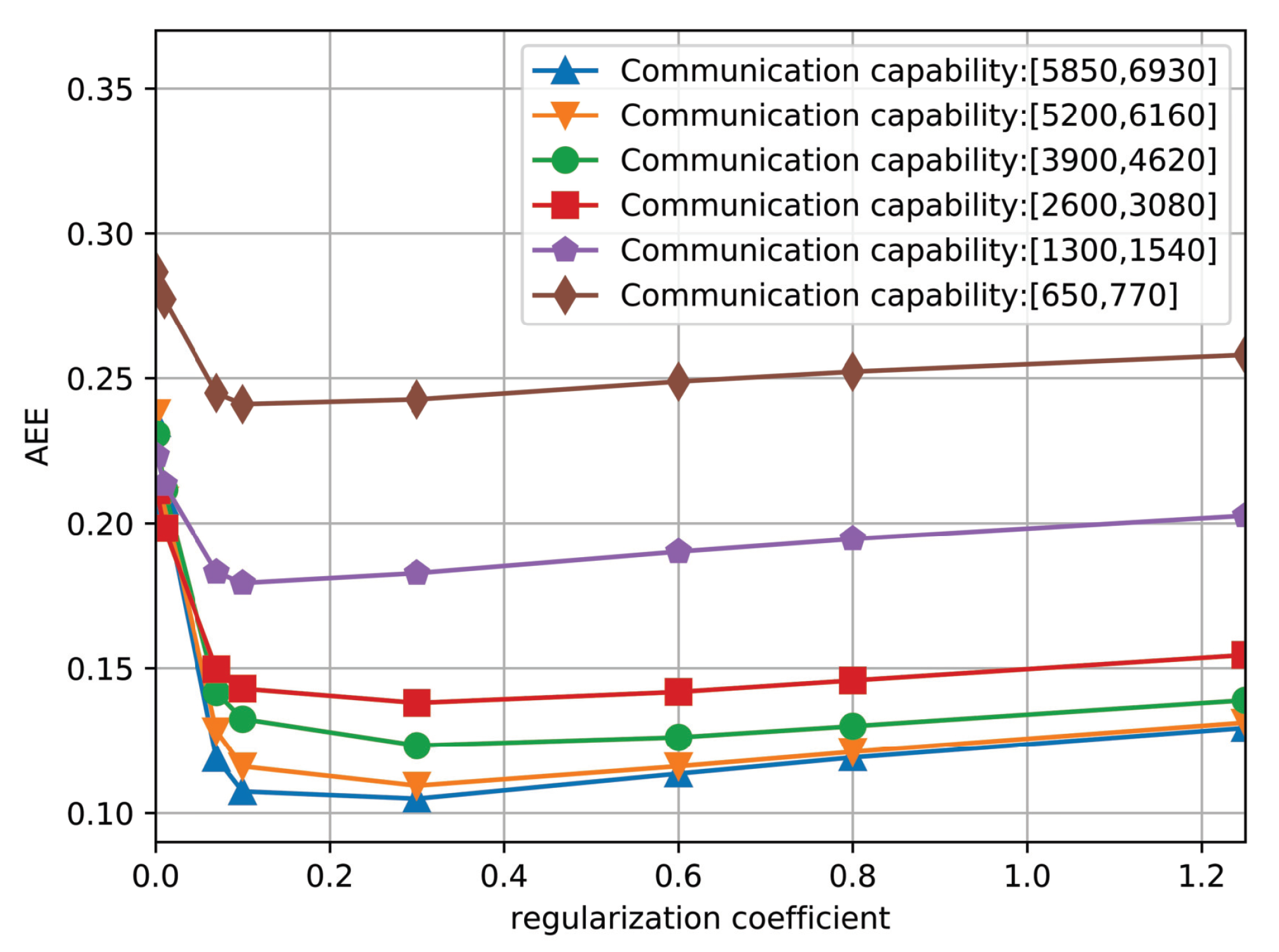
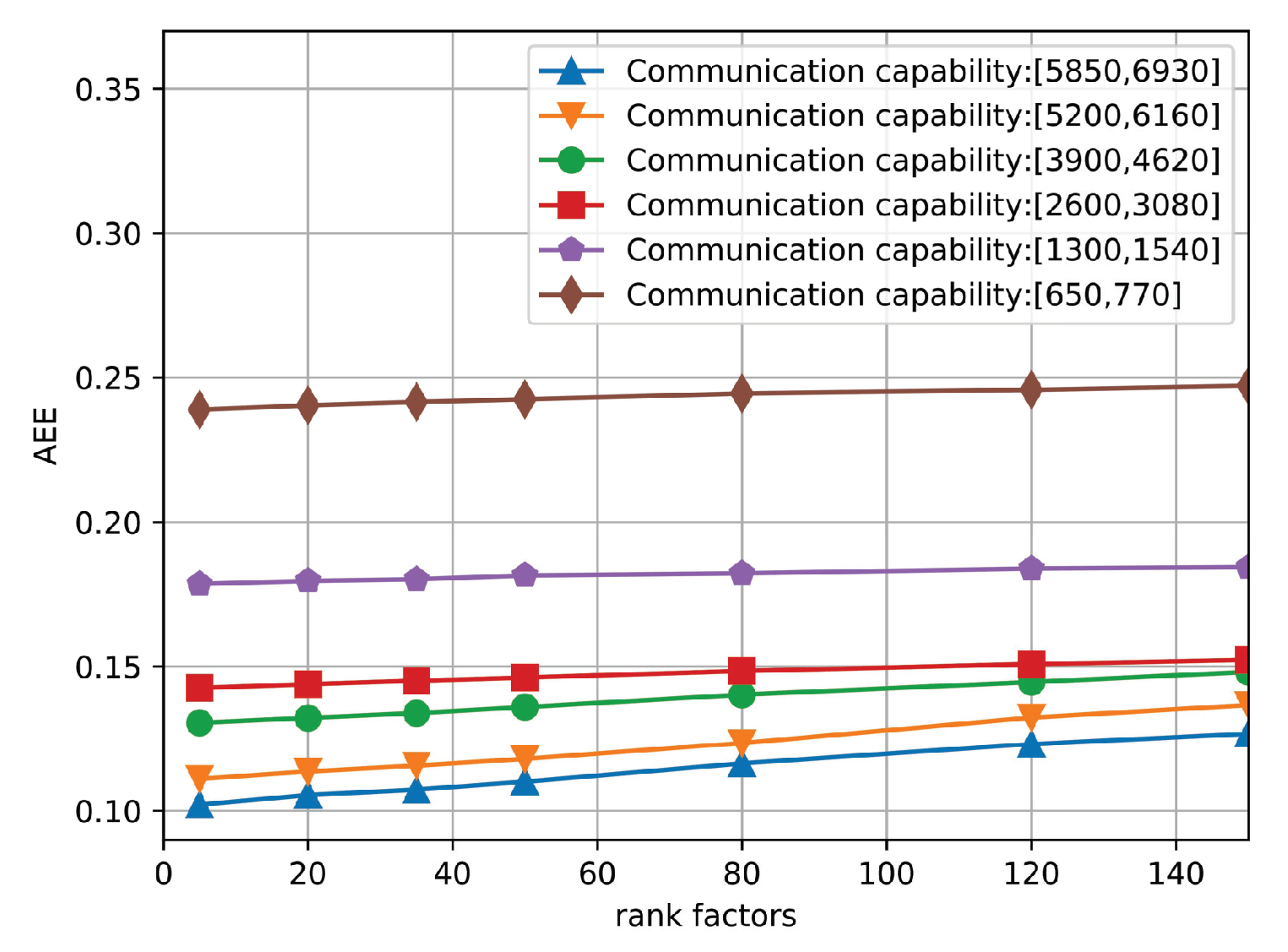
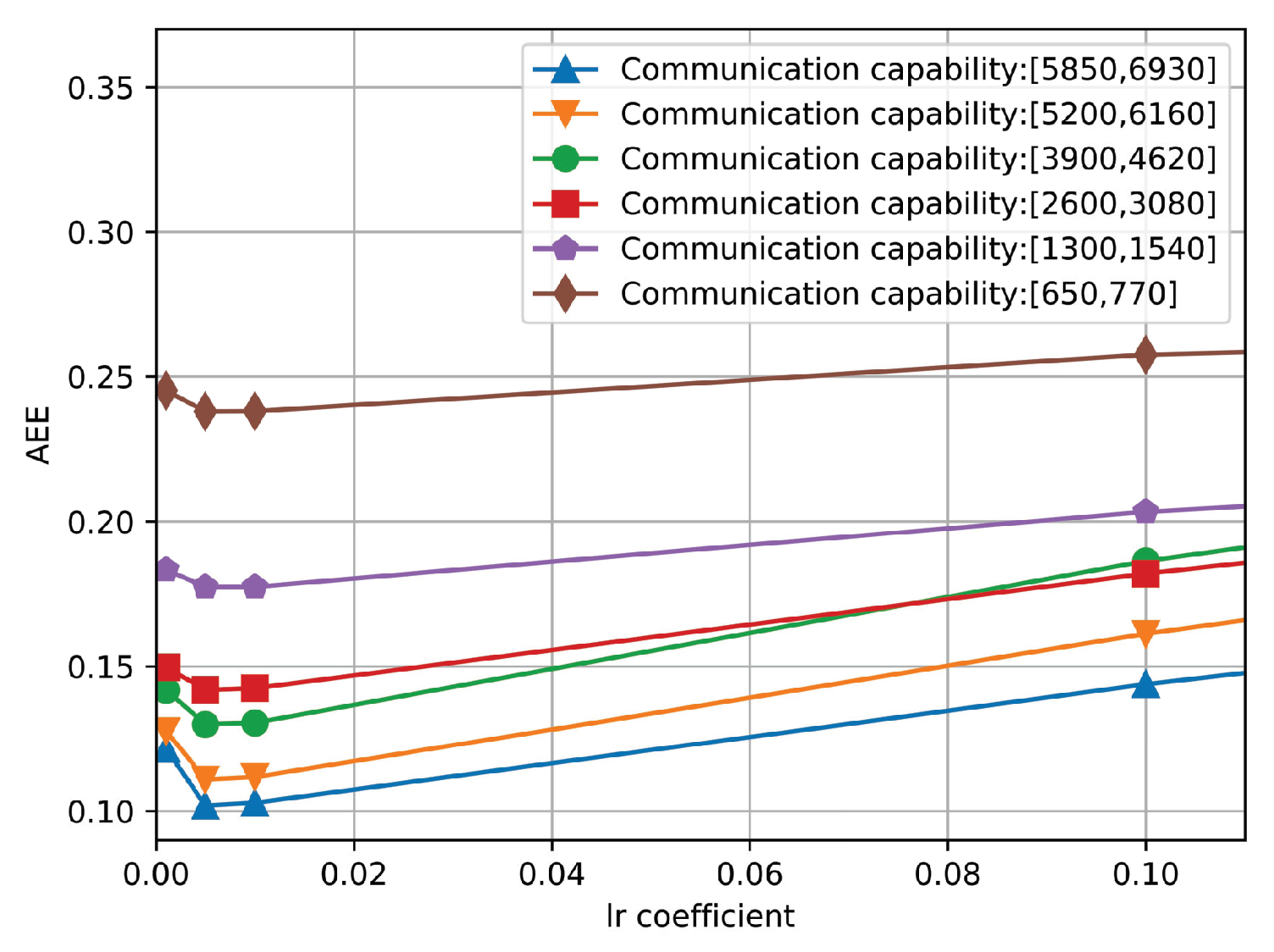
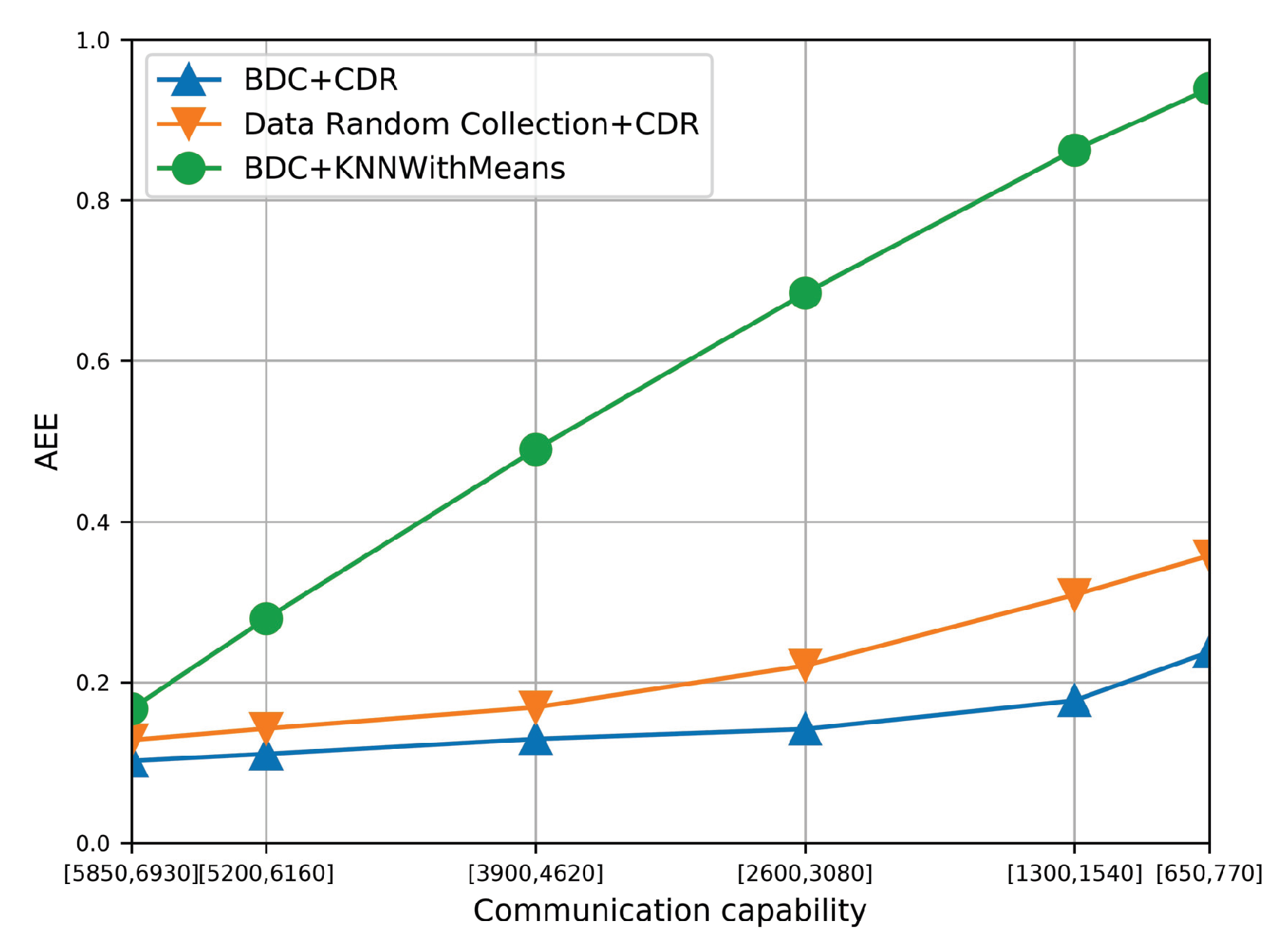
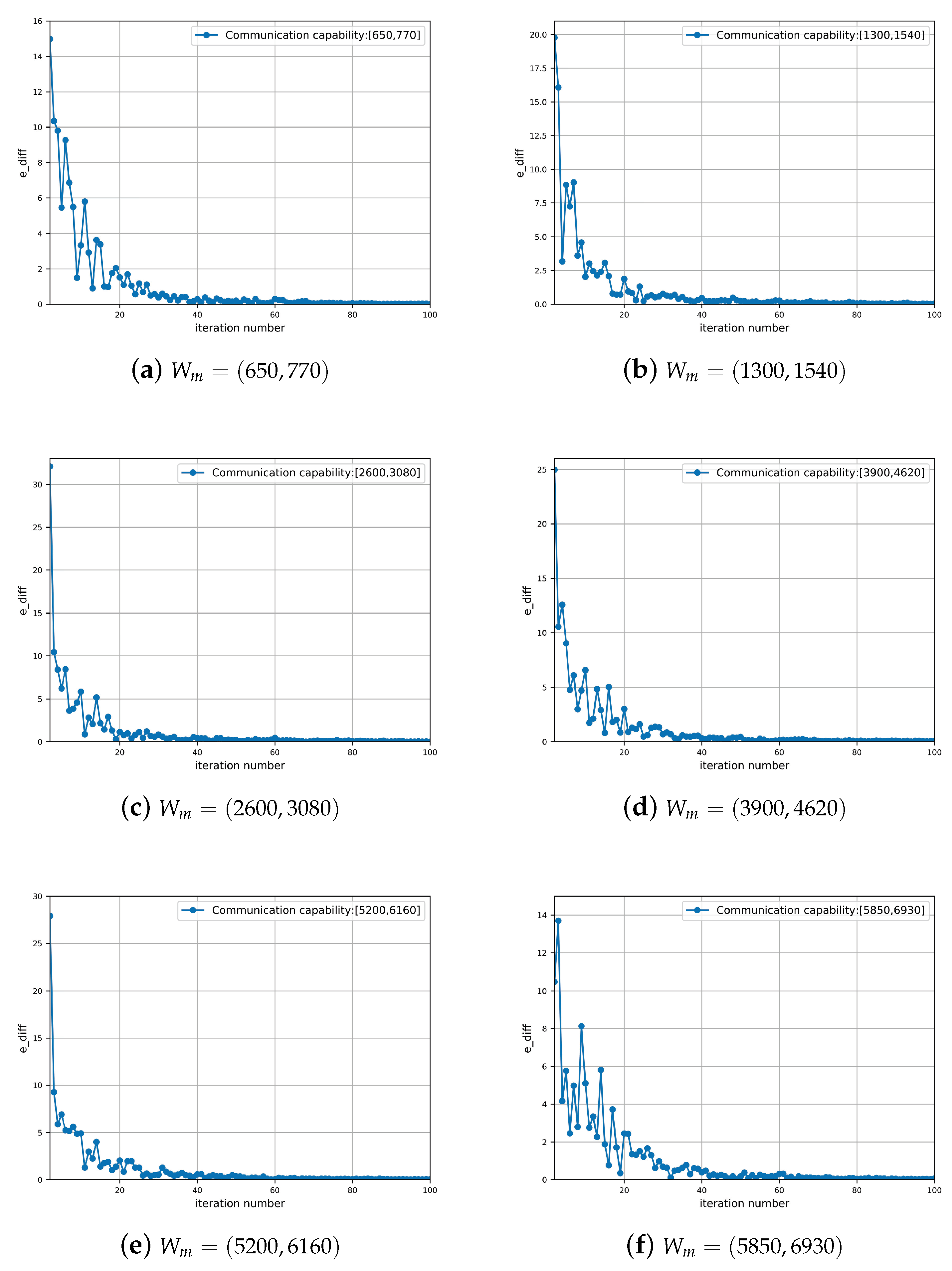
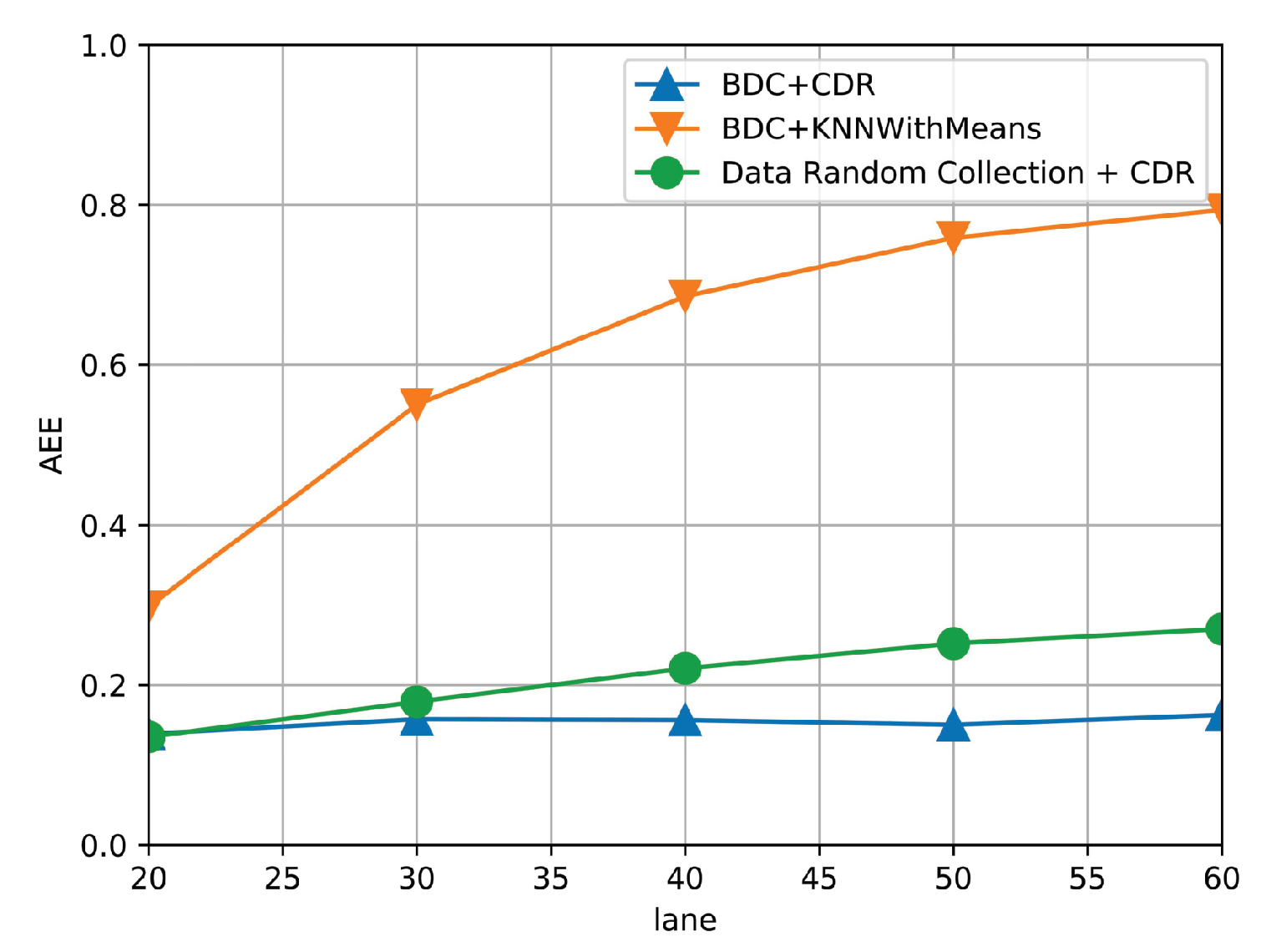
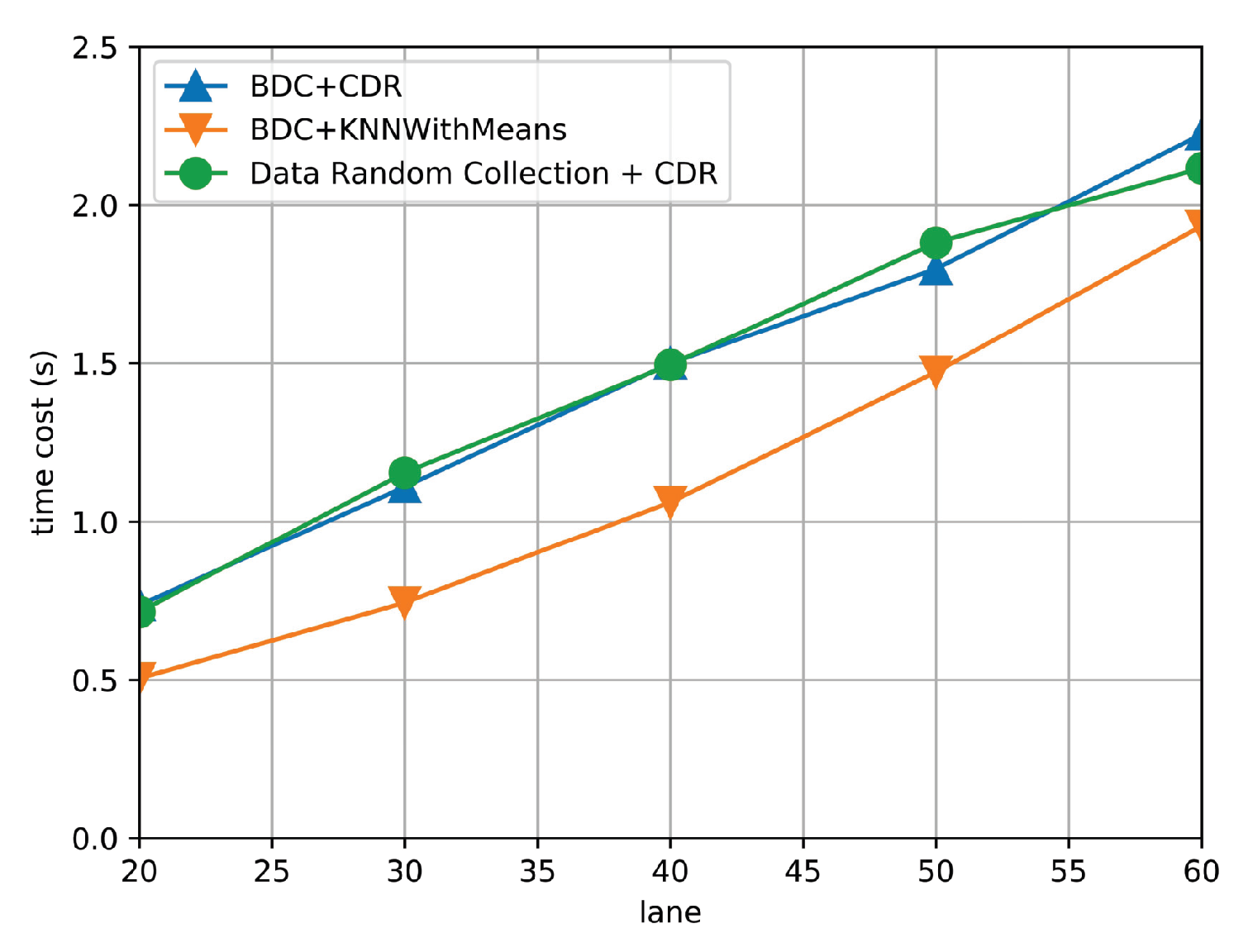

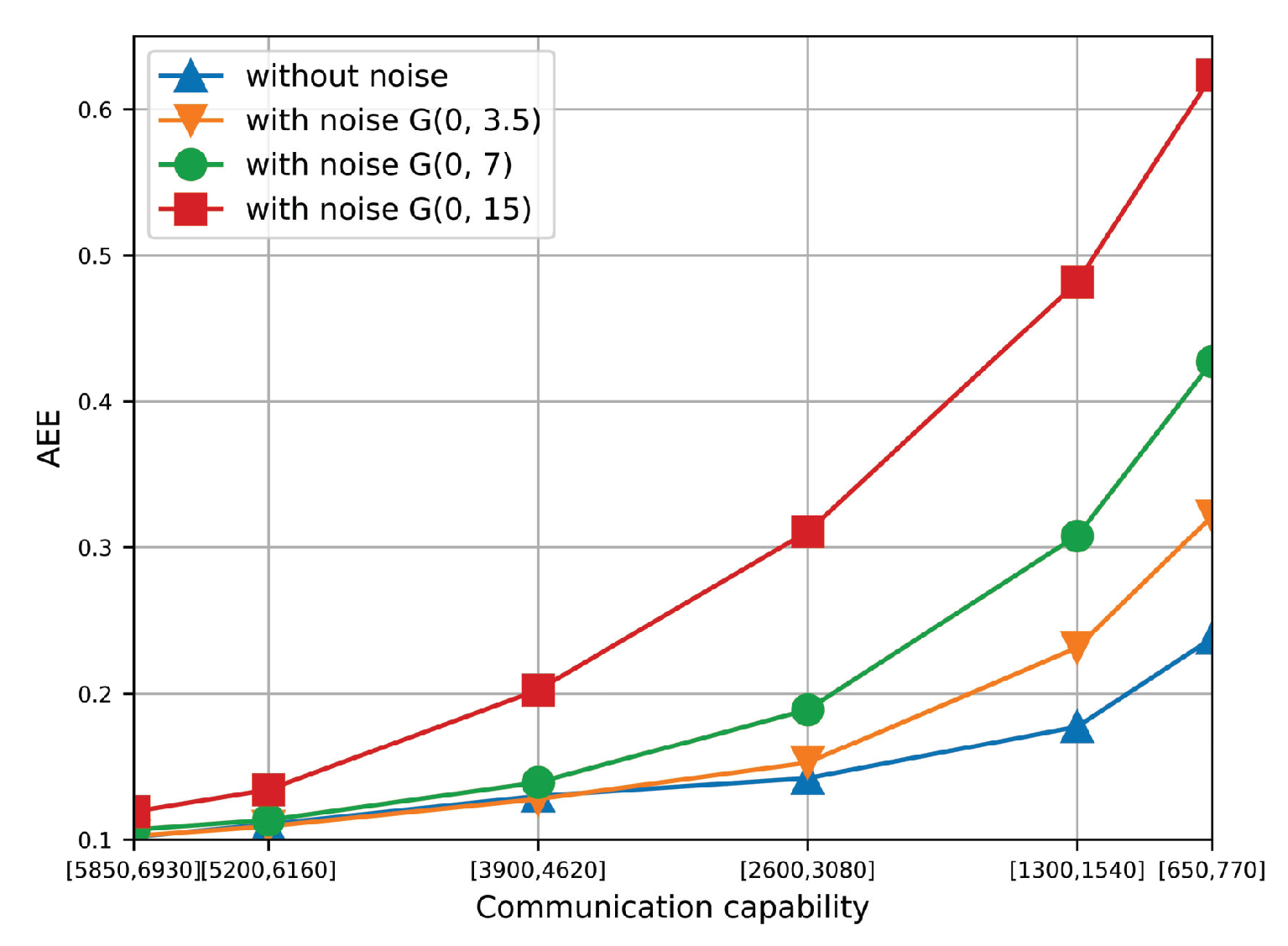
| Field | Driver ID | Time stamp | Altitude | Longitude |
| Type | String | String | String | String |
| Example | jkkt | 1,501,584,540 | 104.04392 | 104.04392 |
| Description | Desensitization | Unix time stamp, second | GCJ-02 coordinate | GCJ-02 coordinate |
| Communication Capacity | [5850,6930] | [5200,6160] | [3900,4620] | [2600,3080] | [1300,1540] | [650,770] |
|---|---|---|---|---|---|---|
| MEC-based architecture | 0.10185 | 0.11081 | 0.13002 | 0.14193 | 0.17738 | 0.23793 |
| Centralized architecture | 0.09587 | 0.10683 | 0.12986 | 0.1416 | 0.17181 | 0.23663 |
© 2019 by the authors. Licensee MDPI, Basel, Switzerland. This article is an open access article distributed under the terms and conditions of the Creative Commons Attribution (CC BY) license (http://creativecommons.org/licenses/by/4.0/).
Share and Cite
Ye, K.; Dai, P.; Wu, X.; Ding, Y.; Xing, H.; Yu, Z. Bandwidth-Aware Traffic Sensing in Vehicular Networks with Mobile Edge Computing. Sensors 2019, 19, 3547. https://doi.org/10.3390/s19163547
Ye K, Dai P, Wu X, Ding Y, Xing H, Yu Z. Bandwidth-Aware Traffic Sensing in Vehicular Networks with Mobile Edge Computing. Sensors. 2019; 19(16):3547. https://doi.org/10.3390/s19163547
Chicago/Turabian StyleYe, Kong, Penglin Dai, Xiao Wu, Yan Ding, Huanlai Xing, and Zhaofei Yu. 2019. "Bandwidth-Aware Traffic Sensing in Vehicular Networks with Mobile Edge Computing" Sensors 19, no. 16: 3547. https://doi.org/10.3390/s19163547
APA StyleYe, K., Dai, P., Wu, X., Ding, Y., Xing, H., & Yu, Z. (2019). Bandwidth-Aware Traffic Sensing in Vehicular Networks with Mobile Edge Computing. Sensors, 19(16), 3547. https://doi.org/10.3390/s19163547




